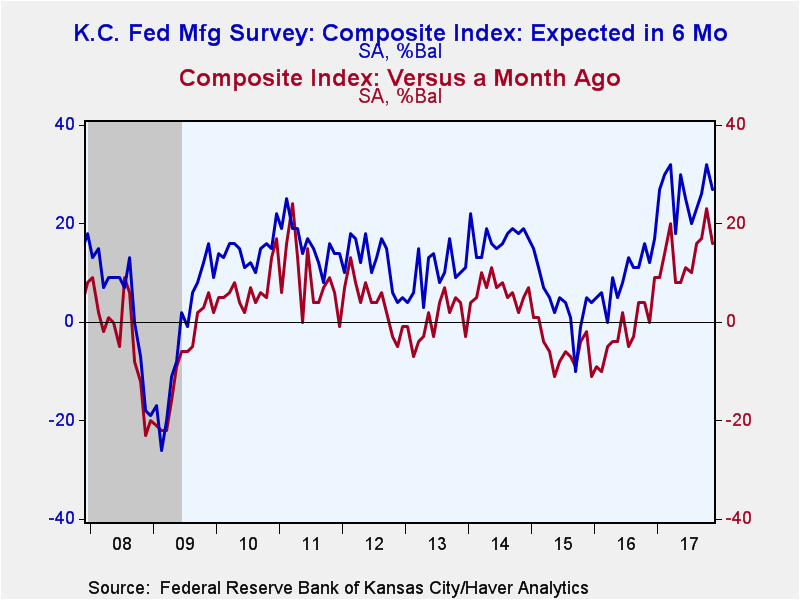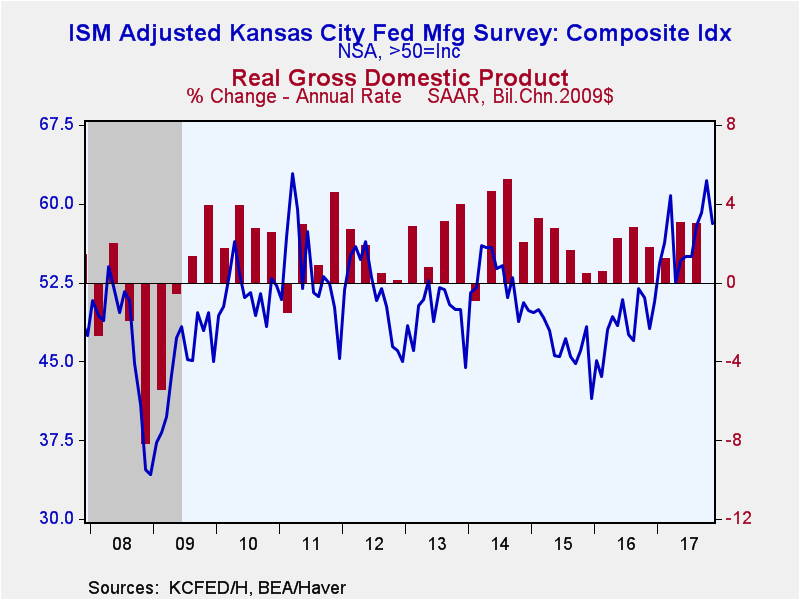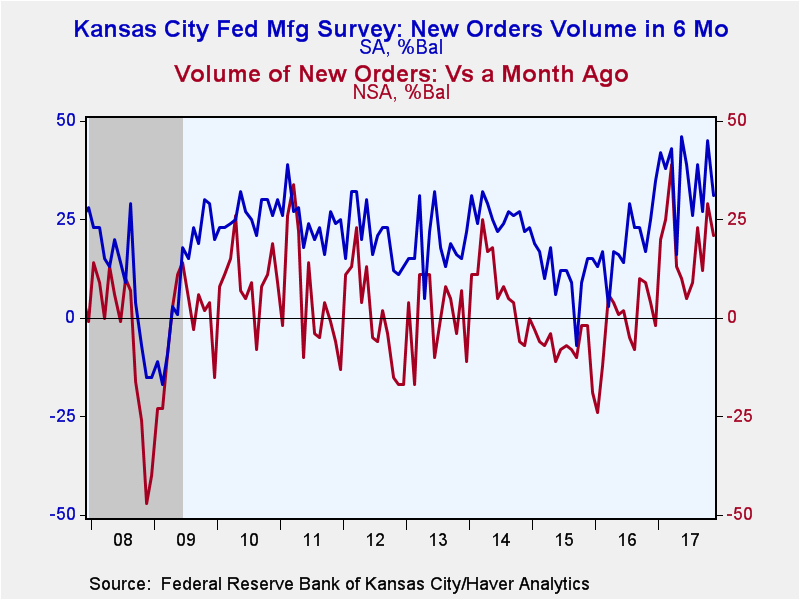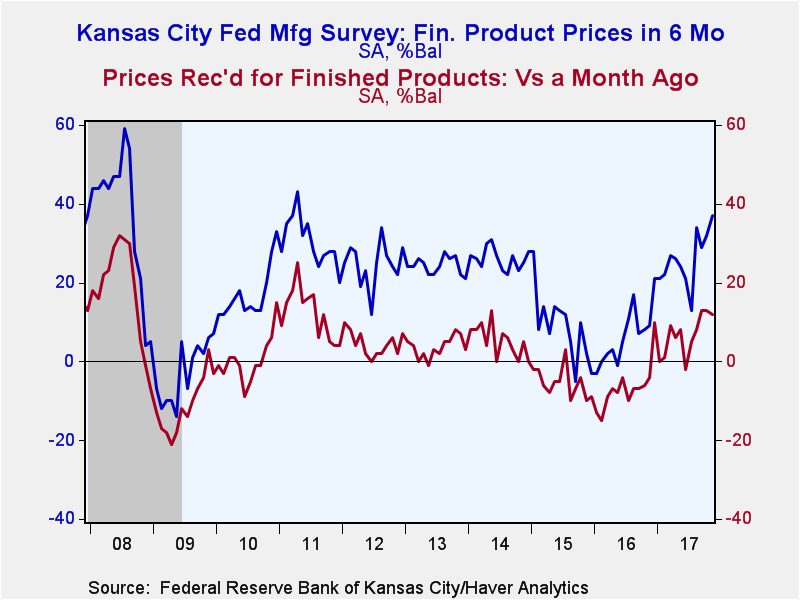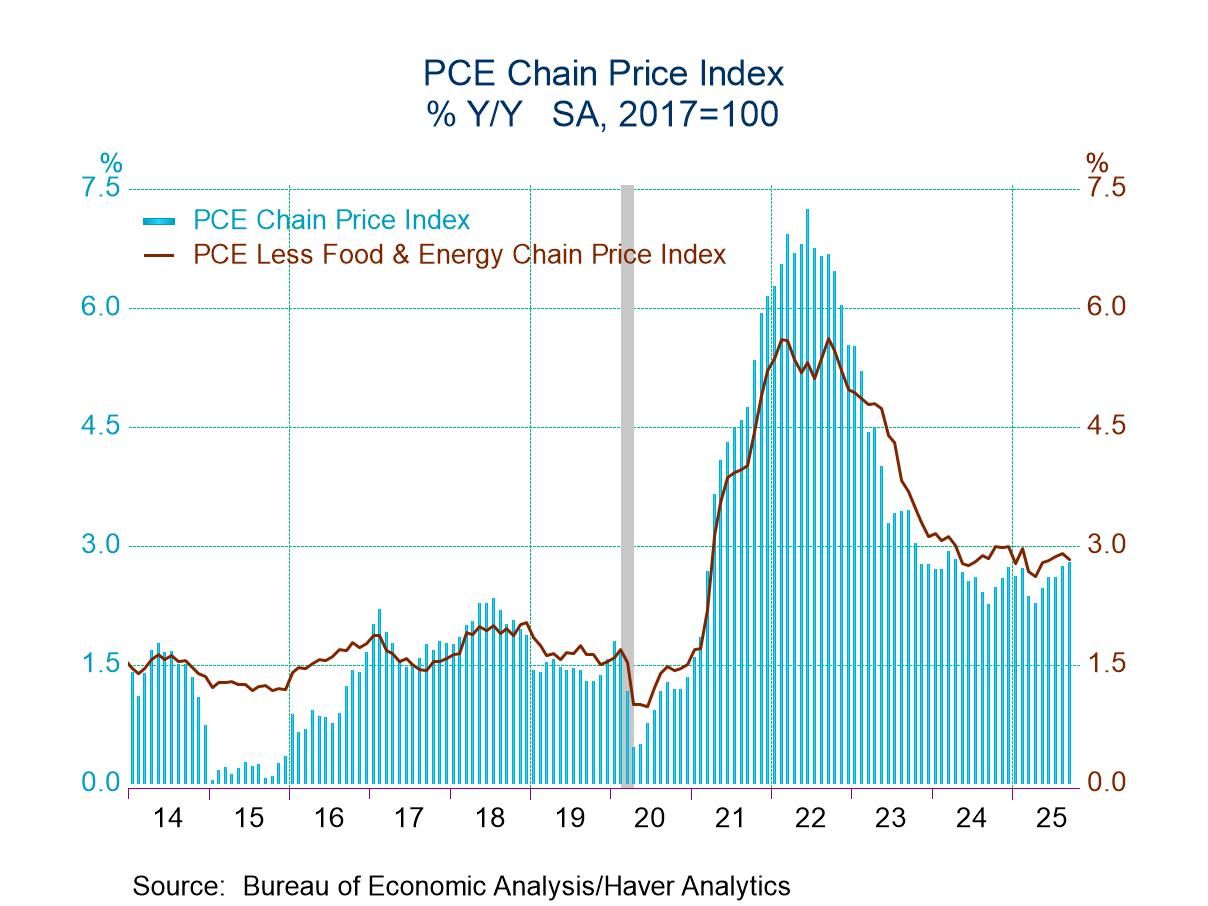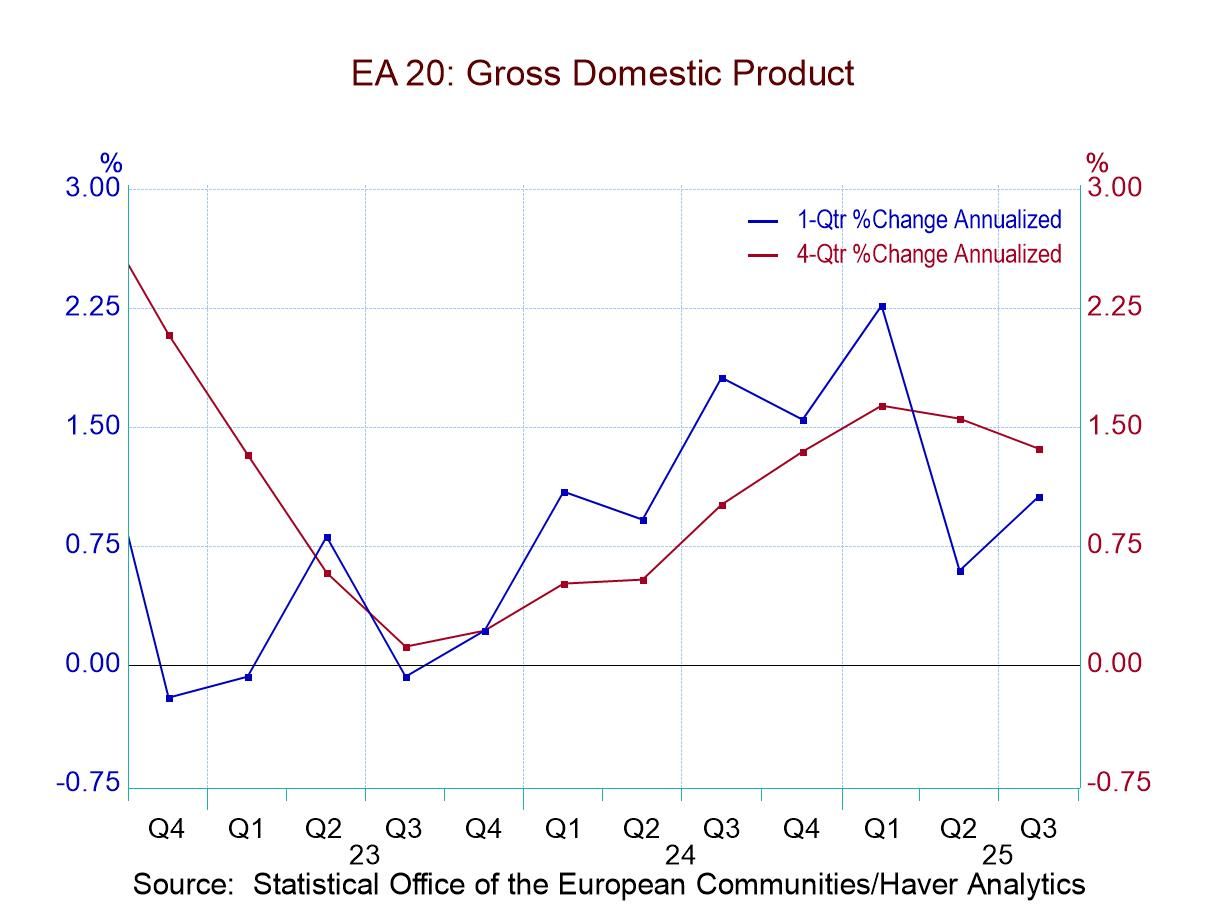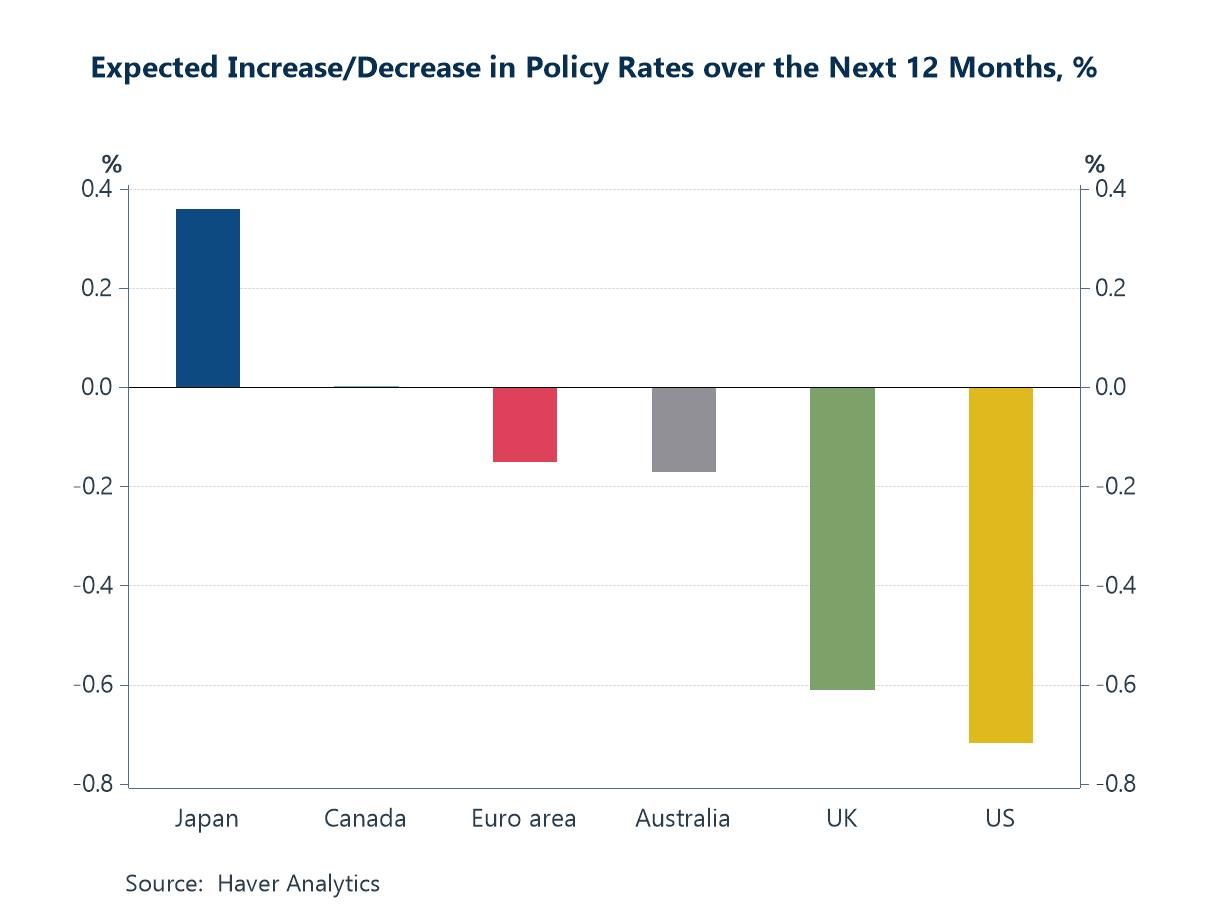 Global| Nov 17 2017
Global| Nov 17 2017Kansas City Federal Reserve Factory Index Weakens
by:Tom Moeller
|in:Economy in Brief
Summary
The Federal Reserve Bank of Kansas City reported that its index of regional manufacturing sector business activity declined to 16 in November following an unrevised October increase to 23. The figure was the lowest reading in three [...]
The Federal Reserve Bank of Kansas City reported that its index of regional manufacturing sector business activity declined to 16 in November following an unrevised October increase to 23. The figure was the lowest reading in three months, but left the positive, two-year trend in place. The ISM-Adjusted index fell to 58.1 (NSA), also its lowest level in three months. During the last ten years, there has been a 57% correlation between this index and the q/q change in real GDP.
Movement amongst the index components was negative. Production, new orders & shipments each fell following earlier increases. The inventory measure also fell. The supplier delivery index collapsed, showing the quickest delivery speeds since April. Export orders also fell to a four-month low; and unfilled orders eased.
Employment slipped, but remained in its recent up-trend. Thirty percent of respondents reported increased hiring while 12% reported a decline in job levels. The employee workweek measure also fell moderately.
The index of finished goods prices slipped following last month's stability. It remained up significantly since the January 2015 low. The raw materials prices index also eased m/m, but remained significantly improved versus the 2015 low.
The overall expectations index posted a moderate decline following its October jump. Expected new & export orders, shipments, production and the employee workweek each fell. Employment held steady and the delivery time measure rose. Capital spending slipped, but remained in the recent up-trend.
Expectations for finished goods prices moved to an expansion high, up sharply since the September 2015 low. Expected raw material prices also jumped to the highest level since March.
The diffusion indexes are calculated as the percentage of total respondents reporting increases minus the percentage reporting declines. The survey included 94 responses from plants in Colorado, Kansas, Nebraska, Oklahoma, Wyoming and northern New Mexico. Data for the Kansas City Fed Survey can be found in Haver's SURVEYS database.
| Kansas City Federal Reserve Manufacturing Survey (SA) | Nov | Oct | Sep | Nov '16 | 2016 | 2015 | 2014 |
|---|---|---|---|---|---|---|---|
| Conditions Versus One Month Ago (% Balance) | 16 | 23 | 17 | 0 | -2 | -6 | 6 |
| ISM-Adjusted Composite Index (NSA) | 58.1 | 62.2 | 59.2 | 48.1 | 48.5 | 46.8 | 52.7 |
| New Orders Volume | 22 | 27 | 10 | 5 | -1 | -8 | 7 |
| Number of Employees | 16 | 21 | 18 | -1 | -6 | -10 | 5 |
| Production | 15 | 20 | 22 | 5 | 1 | -5 | 7 |
| Prices Received for Finished Product | 12 | 13 | 13 | -4 | -7 | -5 | 5 |
| Expected Conditions in Six Months | 27 | 32 | 26 | 12 | 9 | 4 | 17 |
| New Orders Volume | 31 | 45 | 27 | 25 | 19 | 11 | 26 |
| Number of Employees | 35 | 35 | 26 | 6 | 8 | 6 | 18 |
| Production | 40 | 47 | 38 | 23 | 20 | 11 | 28 |
| Prices Received for Finished Product | 37 | 32 | 29 | 9 | 6 | 9 | 26 |
Tom Moeller
AuthorMore in Author Profile »Prior to joining Haver Analytics in 2000, Mr. Moeller worked as the Economist at Chancellor Capital Management from 1985 to 1999. There, he developed comprehensive economic forecasts and interpreted economic data for equity and fixed income portfolio managers. Also at Chancellor, Mr. Moeller worked as an equity analyst and was responsible for researching and rating companies in the economically sensitive automobile and housing industries for investment in Chancellor’s equity portfolio. Prior to joining Chancellor, Mr. Moeller was an Economist at Citibank from 1979 to 1984. He also analyzed pricing behavior in the metals industry for the Council on Wage and Price Stability in Washington, D.C. In 1999, Mr. Moeller received the award for most accurate forecast from the Forecasters' Club of New York. From 1990 to 1992 he was President of the New York Association for Business Economists. Mr. Moeller earned an M.B.A. in Finance from Fordham University, where he graduated in 1987. He holds a Bachelor of Arts in Economics from George Washington University.


